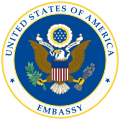| Embassy of the United States of America in Burma | |
|---|---|
 | |
 | |
| Location | Rangoon, Burma |
| Address | 110 University Avenue Road, Kamayut Township |
| Coordinates | 16°49′32″N96°08′41″E / 16.82543°N 96.14473°E |
| Relocated | August 2007 |
| Ambassador | Susan N. Stevenson (Chargé d'Affairs ad interim) |
| Website | mm |
The Embassy of the United States of America in Rangoon represents the official diplomatic mission of the American government in Burma (Myanmar), provides assistance to American citizens and issues visas to foreign nationals, for the purposes of visiting and immigration.